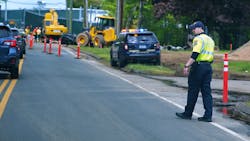Long-distance truckers have earned an iconic image. Rugged, self-reliant individuals, working long hours, and battling traffic, sun glare and misbehaving four-wheelers. Loners in a lonely world, doing what has to be done.
Legends always contain at least a kernel of truth and truth is how they become legends. As legendary and indispensable as any single truck driver may become, there are some things better done together, as a team. Safety is one of them.
Consider as a parallel the solo highway patrol officer. Rugged, self-reliant, working long hours, and, yes, out there amid sun glare, traffic and misbehavior of all sorts. But the effectiveness of that one officer is multiplied by the organization behind them and by the strength of team communications.
For example, here is what happens during an emergency, when that solo officer is sent out to direct traffic away from harm.
In an emergency, such as fire, earthquake, or riots, state, county and local agencies work together to create an “incident command center.” Each of the major players have representation with defined roles in the process. The incident commander comes from the organization that has the primary jurisdiction. Agency representatives in the command center make all major decisions or approvals. Once they make a decision on any aspect of the emergency response, they relay it through their respective agencies, right down to the individual highway patrol officer directing traffic. Their goal is the protection of lives and property – that is, safety.
Motor carriers can similarly improve safety through team communications. Management – equal to a daily “command center” – must set open, transparent communication among all employees as the standard. With the business goal of delivering freight safely and on time, management should underscore that safety of drivers and all employees, vehicles, freight and the public sharing the roads is a personal commitment each team member owes to the other.
Drivers must perform all pre and post-trip vehicle inspections and communicate the results, good and bad. Only then can maintenance focus on which vehicles need immediate attention and openly communicate repair times. Dispatchers then know what trucks are safe, compliant and ready for the road, while drivers can schedule rest breaks if repairs will take a while.
Sales staff should keep everyone updated about new developments with customers and freight, particularly hazardous materials that require special handling. Drivers should report information on travel times, delays and safety issues for each route, plus the location of safe and legal truck parking to fellow drivers and dispatchers. Management must openly share company safety goals, shortcomings, achievements and congratulations.
Finally, team communications provide any team member the ability to call an “all stop.” This happens when a safety issue demands immediate attention, ranging from a systemic equipment issue to a dangerously mislabeled freight shipment to a crash. An “all stop” says we must set aside the business goals and attend to our personal commitment to safety.
As for the lonely long-distance truck driver, think of how much more successful and safer they can be with a whole team openly communicating in support. And speaking of building team communication, don’t forget to include your highway patrol. We share safety as our own commitment. Working together we can make safe highways a reality.
______________________________
Steve Vaughn is the vice president of field operations at PrePass Safety Alliance, the provider of PrePass weigh station bypass service. Vaughn served nearly three decades with the California Highway Patrol and is a past president of the Commercial Vehicle Safety Alliance.
About the Author
Steve Vaughn
Senior Vice President of Field Operations
Steve Vaughn is senior vice president of field operations at PrePass Safety Alliance, the provider of PrePass weigh station bypass and electronic toll-payment and management services. Vaughn served nearly three decades with the California Highway Patrol and is a past president of the Commercial Vehicle Safety Alliance.
